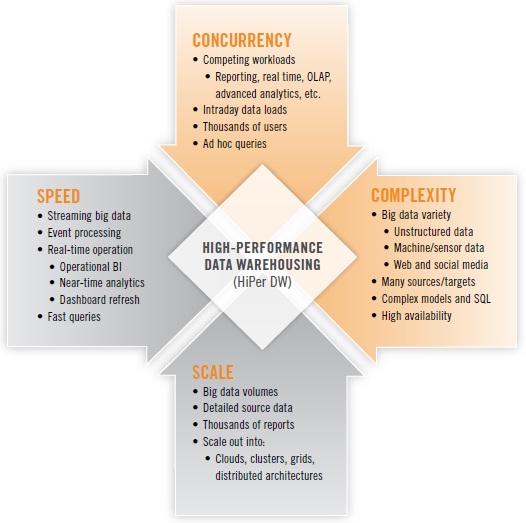The Four Dimensions of High-Performance Data Warehousing
By Philip Russom, TDWI Research Director
[NOTE -- My new TDWI report about High-Performance Data Warehousing (HiPer DW) is finished and will be published in October. The report’s Webinar will broadcast on October 9, 2013. In the meantime, I’ll leak a few of the report’s findings in this blog series. Search Twitter for #HiPerDW to find other leaks. Enjoy!]
FIGURE 1.

High-performance data warehousing (HiPer DW) is primarily about achieving speed and scale, while also coping with increasing complexity and concurrency. These are the four dimensions that define HiPer DW. Each dimension can be a goal unto itself; yet, the four are related. For example, scaling up may require speed, and complexity and concurrency tend to inhibit speed and scale. The four dimensions of HiPer DW are summarized in Figure 1 above.
Here follow a few examples of each:
SPEED. The now-common practice of operational BI usually involves fetching and presenting operational data (typically from ERP and CRM applications) in real time or close to it. Just as operational BI has pushed many organizations closer and closer to real-time operation, the emerging practice of operational analytics will do the same for a variety of analytic methods. Many analytic methods are based on SQL, making the speed of query response more urgent than ever. Other analytic methods are even more challenging for performance, due to iterative analytic operations for variable selection and reduction, binning, and neural net construction. Out on the leading edge, events and some forms of big data stream from Web servers, transactional systems, media feeds, robotics, and sensors; an increasing number of user organizations are now capturing and analyzing these streams, then making decisions or taking actions within minutes or hours.
SCALE. Upon hearing the term “scalability,” most of us immediately think of the burgeoning data volumes we’ve been experiencing since the 1990s. Data volumes have recently spiked in the phenomenon known as “big data,” which forces organizations to manage tens of terabytes – sometimes hundreds of terabytes, even petabytes – of detailed source data of varying types. But it’s not just data volumes and the databases that manage them. Scalability is also required of BI platforms that now support thousands of users, along with their thousands of reports that must be refreshed. Nor is it just a matter of scaling up; all kinds of platforms must scale out into ever larger grids, clusters, clouds, and other distributed architectures.
COMPLEXITY. Complexity has increased steadily with the addition of more data sources and targets, not to mention more tables, dimensions, and hierarchies within DWs. Today, complexity is accelerating, as more user organizations embrace the diversity of big data, with its unstructured data, semi-structured data, and machine data. As data’s diversity increases, so does the complexity of its management and processing. Some organizations are assuring high performance for some workloads (especially real time and advanced analytics) by deploying standalone systems for these; one of the trade-offs is that the resulting distributed DW architecture has complexity that makes it difficult to optimize the performance of processes that run across multiple platforms.
CONCURRENCY. As we scale up to more analytic applications and more BI users, an increasing number of them are concurrent—that is, using the BI/DW/DI and analytics technology stack simultaneously. In a similar trend, the average EDW now supports more database workloads – more often running concurrently – than ever before, driven up by the growth of real-time operation, event processing, advanced analytics, and multi-structured data.
Want more? Register for my HiPer DW Webinar, coming up Oct.9 noon ET.
Read other blogs in this series:
Defining HiPerDW
High Performance: The Secret of Success and Survival